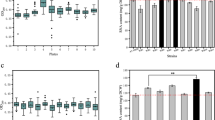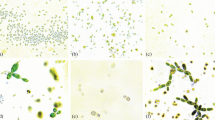Abstract
Attempts were made with success to develop a two-step biocatalytic process for uridine 5′-monophosphate (UMP) production from orotic acid by Corynebacterium ammoniagenes ATCC 6872: the strain was first cultivated in a high salt mineral medium, and then cells were harvested and used as the catalyst in the UMP production reaction. Effects of cultivation and reaction conditions on UMP production were investigated. The cells exhibited the highest biocatalytic ability when cultivated in a medium containing corn steep liquor at pH 7.0 for 15 h in the exponential phase of growth. To optimize the reaction, both “one-factor-at-a-time” method and statistical method were performed. By “one-factor-at-a-time” optimization, orotic acid, glucose, phosphate ion (equimolar KH2PO4 and K2HPO4), MgCl2, Triton X-100 were shown to be the optimum components for the biocatalytic reaction. Phosphate ion and C. ammoniagenes cell were furthermore demonstrated as the most important main effects on UMP production by Plackett–Burman design, indicating that 5-phosphoribosyl-1-pyrophosphate (PRPP) synthesis was the rate-limiting step for pyrimidine nucleotides production. Optimization by a central composition design (CCD) was then performed, and up to 32 mM (10.4 g l−1) UMP was accumulated in 24 h from 38.5 mM (6 g l−1) orotic acid. The yield was threefold higher than the original UMP yield before optimization.





Similar content being viewed by others
References
Abbouni B, Elhariry HM, Auling G (2004) Overproduction of NAD+ and 5′-inosine monophosphate in the presence of 10 μM Mn2+ by a mutant of Corynebacterium ammoniagenes with thermosensitive nucleotide reduction (nrd ts) after temperature shift. Arch Microbiol 182:119–125
Auling G, Thaler M, Diekmann H (1980) Parameters of unbalanced growth and reversible inhibition of deoxyribonucleic acid synthesis in Brevibacterium ammoniagenes ATCC 6872 induced by depletion of Mn2+. Inhibitor studies on the reversibility of deoxyribonucleic acid synthesis. Arch Microbiol 127:105–114
Brown PR, Robb CS, Geldart SE (2002) Perspectives on analyses of nucleic acid constituents: the basis of genomics. J Chromatogr A 965:163–173
Chen QH, He GQ, Ali MAM (2002) Optimization of medium composition for the production of elastase by Bacillus sp. EL31410 with response surface methodology. Enzyme Microb Technol 30:667–672
Endo T, Koizumi S, Tabata K, Ozaki A (2000) Large-scale production of CMP-NeuAc and sialylated oligosaccharides through bacterial coupling. Appl Microbiol Biotechnol 53:257–261
Endo T, Koizumi S, Tabata K, Kakita S, Ozaki A (2001) Large-scale production of the carbohydrate portion of the sialyl-Tn epitope, α-Neup5Ac-(2-6)-d-GalpNAc, through bacterial coupling. Carbohydr Res 330:439–443
Fujio T, Maruyama A (1997) Enzymatic production of pyrimidine nucleotides using Corynebacterium ammoniagenes cells and recombinant Escherichia coli cells: enzymatic production of CDP-choline from orotic acid and choline chloride (Part I). Biosci Biotechnol Biochem 61:956–959
Henriksen A, Aghajari N, Jensen KF, Gajhede M (1996) A flexible loop at the dimer interface is a part of the active site of the adjacent monomer of Escherichia coli orotate phosphoribosyltransferase. Biochemistry 35:3803–3809
Kamada N, Yasuhara A, Ikeda M (2003) Significance of the non-oxidative route of the pentose phosphate pathway for supplying carbon to the purine-nucleotide pathway in Corynebacterium ammoniagenes. J Ind Microbiol Biotechnol 30:129–132
Lee HC, Lee S, Sohng JK, Liou K (2004) One-pot enzymatic synthesis of UDP-d-glucose from UMP and glucose-1-phosphate using an ATP regeneration system. J Biochem Mol Biol 37:503–506
Maruyama A, Fujio T (2001) ATP production from adenine by a self-coupling enzymatic process: high-level accumulation under ammonium-limited conditions. Biosci Biotechnol Biochem 65:644–650
Nahálka J, Liu Z, Germeiner P, Wang P (2002) Nucleoside triphosphates production using recombinant Escherichia coli entrapped in calcium pectate gel. Biotechnol Lett 24:925–930
Nakayama K, Tanaka H (1971) Production of nucleic acid-related substances by fermentative processes XXXVIII. Production of uridine 5′-monophosphate and orotidine 5′-monophosphate by Brevibacterium ammoniagenes. Agr Biol Chem 35:518–525
Naveena BJ, Altaf M, Bhadriah K, Reddy G (2005) Selection of medium components by Plackett–Burman design for production of L(+) lactic acid by Lactobacillus amylophilus GV6 in SSF using wheat bran. Bioresour Technol 96:485–490
Nudler AA, Garibyan AG, Bourd GI (1991) The derepression of enzymes of de novo pyrimidine biosynthesis pathway in Brevibacterium ammoniagenes producing uridine-5-monophosphate and uracil. FEMS Microbiol Lett 66:263–266
Oka T, Udagawa K, Kinoshita S (1968) Unbalanced growth death due to depletion of Mn2+ in Brevibacterium ammoniagenes. J Bacteriol 96:1760–1767
Plackett R, Burman J (1946) The design of optimum multifactorial experiments. Biometrika 33:305–325
Stowe RA, Mayer RP (1966) Efficient screening of process variables. Ind Eng Chem 58:36–40
Tabata K, Koizumi S, Endo T, Ozaki A (2000) Production of UDP-N-acetylglucosamine by coupling metabolically engineered bacteria. Biotechnol Lett 22:479–483
Tortora GJ, Funke BR, Case CL (1992) Microbiology: an introduction. Benjamin/Cummings, Redwood City California
Varki A (1993) Biological roles of oligosaccharides: all of the theories are correct. Glycobiology 3:97–130
Acknowledgements
The work was supported by the Scientific Research Foundation for the Returned Overseas Chinese Scholars and Key Foundation of the State Education Ministry (Grant no. 106102) and a grant from the Ministry of Science and Technology of China (National Basic Research Program of China, 2007CB707803). The authors also gratefully acknowledge the financial support of this work by Shanghai Apple Flavor & Fragrance Co., Ltd. (China).
Author information
Authors and Affiliations
Corresponding author
Rights and permissions
About this article
Cite this article
Wang, X., Wang, X., Yin, M. et al. Production of uridine 5′-monophosphate by Corynebacterium ammoniagenes ATCC 6872 using a statistically improved biocatalytic process. Appl Microbiol Biotechnol 76, 321–328 (2007). https://doi.org/10.1007/s00253-007-1013-x
Received:
Revised:
Accepted:
Published:
Issue Date:
DOI: https://doi.org/10.1007/s00253-007-1013-x




